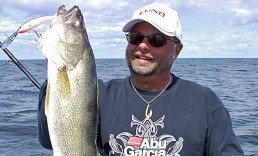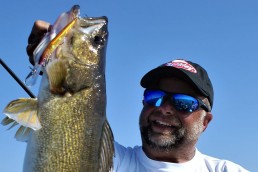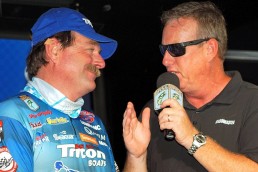Pulling for Post-spawners: Big Walleyes are Still in Great Lakes
SHARE THIS POST
Spring is a time of transformation within the Great Lakes. Instead of resembling a “moonscape” from the ice and snow, the lakes have taken on the look of open water and white-capped waves. And, their waters are warming rapidly.
Once temperatures rise to 50 degrees and higher, the walleyes that call these lakes home will be done pondering procreation. That urge to spawn, which took precedence over all other functions of their life, is over. So too are the massive migrations that brought loads of these marauders shoreward to congregate onto the reefs and into rivers and streams.
Getting walleyes to bite, especially the “big hens,” is a dilemma after the spawn. This has become so much of a problem that many have forgone fishing these inland seas in lieu of smaller, manageable watersheds—a big mistake.
There are plenty of large walleyes willing to bite in these massive waterways this time of year. And locating them and getting them to eat your offering is not as hard as one might think.
The wait is over
The majority of fish don’t travel far from their spawning grounds afterward. There will be those that head straight for the middle of nowhere to recuperate after the rigors of proliferation, but a good populous will belly up to the bottom close to shore, within close proximity to the reefs and flowing waters that brought them there in the first place.
But these predators are not inactive; they’re still eating. And they don’t have to go far to fill their bellies as this is the time of year when hordes of baitfish and perch and suckers are coming to these same areas to spawn. Imitate this forage to catch fish.
Spot on
Walleyes will head out into the main lake and cruise along the first breaklines offshore, especially at river and creek mouths. They will feast on the baitfish waiting for the rivers to rise, which triggers their mad dash upstream to spawn. This is the time and place I troll, so as to cover as much water as possible.
The depths walleyes are at now may vary from 5 to 30 feet, so I’ll troll within several different depths until I get bit. In addition, I’ll follow the breaklines to a tee, which is crucial. And I can guarantee you that at all times, my eyes will be on the screen of my sonar/GPS.
On the GPS side of the screen, I can see my exact location, as well the lay of the underwater land I’m over. Plus, I can see what’s ahead of me because of a SD card filled with mapping that’s inserted into a unit’s card reader. Without a mapping program it would be difficult to follow the contours accurately.
On the sonar side, I’ll be on the lookout for fish, determining where they are in the water column. And, I always have an eye out for baitfish too. And even though I may not see big fish on the screen, I will at least make sure to get my lures in the same depths the bait is.
Forage factors
Just as fly anglers are always attempting to match the hatch, so too should walleye anglers. If baitfish are in a waterway and they are short and stout in stature, such as the shad in the Great Lakes, I’ll use wide-bodied baits like Rapala Shad Raps and Shallow Shad Raps. If they are long and slender-bodied, such as shiners, smelt and young perch, I’ll use lures with narrow bodies like Rapala Original Minnows, Minnow Raps and Scatter Raps.
Are you enjoying this post?
You can be among the first to get the latest info on where to go, what to use and how to use it!
For lure size, I’ll match that to the average size of the forage in the area. For example, while a size 5 Shad Rap may be best when a small alewife is present, a size 18 Original Rapala will best match smelt. Whatever you do, don’t be afraid to use different lures throughout the day.
The color of lures will depend more on water clarity over forage. If it’s clear, I like to use the most natural imitation of the baitfish and fishes at hand with maybe just a splash of bright coloration for appeal. If the water’s stained, I’ll pick out brighter colors, including ultraviolet and fluorescents.
When trolling crankbaits in the cold waters of spring, I’ll troll with my 9.9-hp four-stroke kicker motor, making sure to keep my speed. I determine this through the GPS on my Lowrance: It falls between 1.5 and 2 mph. (One-tenth of a mph, whether it’s faster or slower, can make a difference in catching fish or not.) Watch your GPS intently and make adjustments in speed so as to decipher what pace trips their trigger.
Spin around
If walleyes aren’t interested in crankbaits, I’ll slow my troll to .07 to 1.4 mph and pull spinners (‘crawler harnesses) tipped with a whole nightcrawler fresh from my bait container, or a 7-inch Gulp.
The best blades to use this time of year are size 4 or 5. As for shape, Colorado-style blades give off the most “thump” under water. Indiana blades however, spin the easiest when being pulled at super-slow speeds. Willow blades on the other hand, have less water resistance, thus are preferred when fish are near the bottom in deep water. Northland Fishing Tackle offers all these blade types with “Baitfish-Image” graphics, and these holographic patterns are my favorites.
For picking colors, I use the same process I use for crankbaits.
Look out, way out
Whether I’m trolling crankbaits or spinners, I’ll get more strikes if I get my lines out from behind the boat by using in-line planer boards. Church Tackle’s “The Walleye Board” has an adjustable weight system that makes it ride perfectly horizontal, no matter how large or small of lure I am pulling. These are perfect for trolling in cold water. No matter what lure, I make sure they’re running up off the bottom rather than dredging the lake’s floor.
In the case of crankbaits, I use Shallow Shad Raps and Rapala Originals in water less than 8 feet. Shad Raps, Minnow Raps, and Deep Tail Dancers work well in deeper water. And when pulling spinners, I use bead weights to get those spinners down.
As for trolling gear, I use Berkley’s 8-foot 6-inch medium–action Heritage trolling rods and Abu Garcia line-counter reels. Ten-pound-test Berkley Trilene XL (Extra limp) is the perfect line. This is also a time and place where trolling with leadcore line is a great technique, and I use 12-pound-test Sufix 832 Advanced Lead Core.
Overview
Looking for an outstanding, yet overlooked walleye fishery right after the Great Lakes walleyes spawn? The moment the waters reach 50 degrees, grab your trolling rods, crankbaits and spinners, and troll. Target the waters near the reefs and river mouths where these fish spawn. Just remember to watch your speed; stick tight to the breaklines and you’ll catch fish.
Mark Martin is a professional walleye tournament angler and instructor with the Ice-Fishing School/Vacation series. Check out his website at markmartins.net or fishingvacationschool.com for more information.
MWO
SHARE THIS POST
Did you enjoy this post?
You can be among the first to get the latest info on where to go, what to use and how to use it!
Mark Martin
Mark Martin is a professional walleye tournament angler and instructor with the Ice Fishing School/Vacation series. For more information, check out his website at markmartins.net or fishingvacationschool.com.



